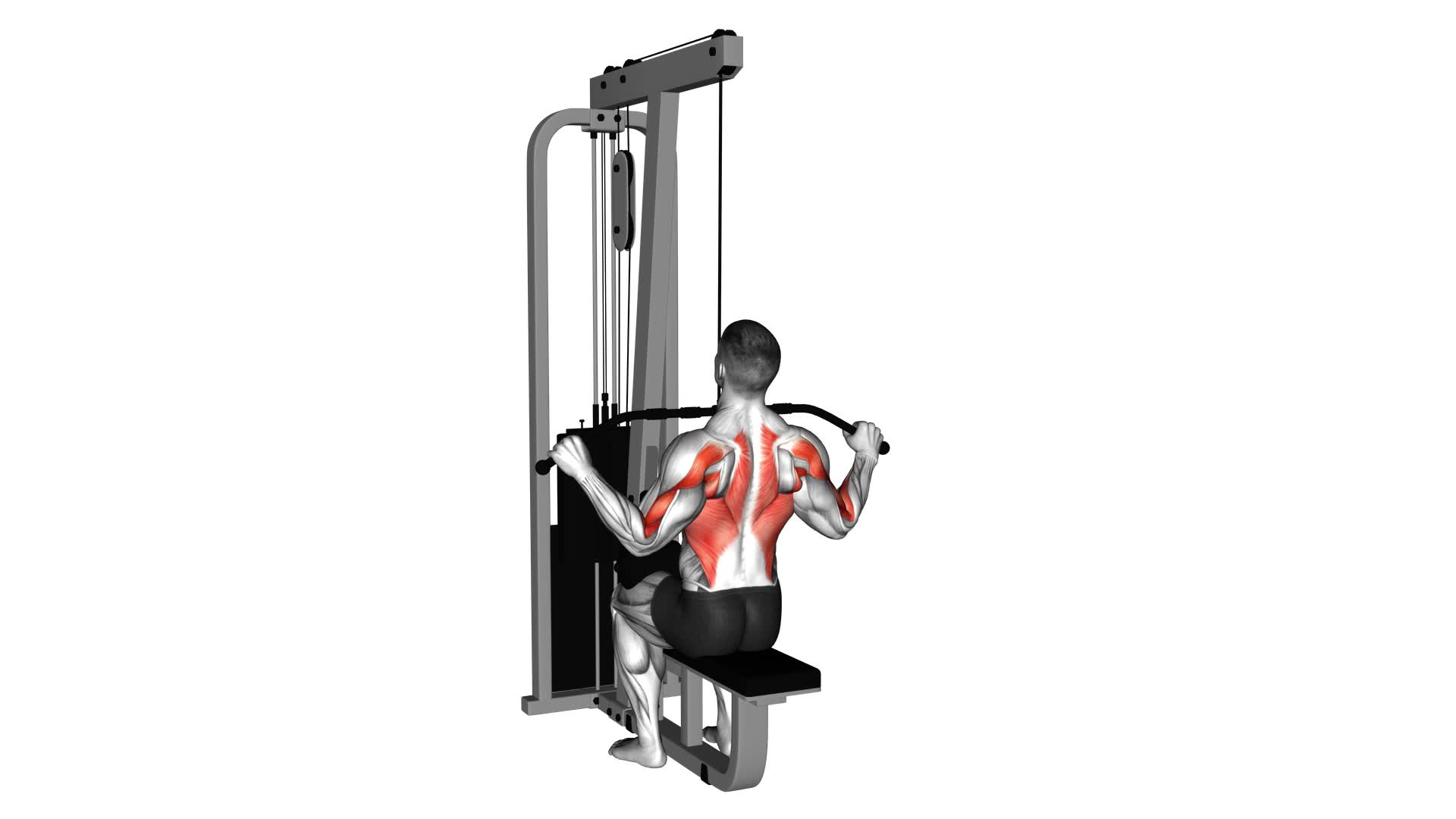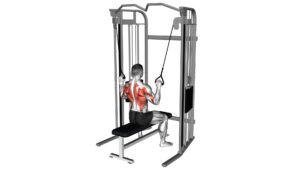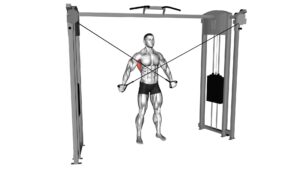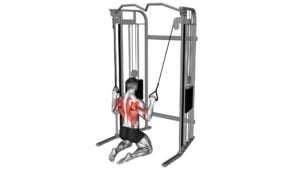Cable Pulldown (Pro Lat Bar) – Video Exercise Guide & Tips

Looking to strengthen your back and build those lats? Check out this video exercise guide and tips for the cable pulldown using the pro lat bar.
Watch This Exercise Video
Learn the benefits of this exercise, proper form and technique, variations to keep it interesting, and common mistakes to avoid.
Get ready to maximize your results and achieve a stronger, more defined back with these helpful tips.
Safety precautions and considerations are also included to ensure a safe and effective workout.
Let's get started!
Key Takeaways
- Cable pulldown exercise builds upper body strength and targets back, shoulders, and arms.
- Proper form and technique are important to maximize muscle activation and reduce the risk of injury.
- Engaging the latissimus dorsi muscles and maintaining body alignment and posture are crucial during the exercise.
- Incorporating variations, modifications, progressive overload techniques, and rest days can help optimize results and prevent overuse injuries.
Benefits of Cable Pulldown Exercise
To maximize your workout, incorporate cable pulldown exercises for the benefits of building upper body strength and improving posture. Cable pulldowns specifically target the muscles in your back, shoulders, and arms, helping you develop a strong and defined upper body. By engaging these muscles, you can improve your overall strength and power for other exercises and daily activities. Additionally, cable pulldowns can help correct and improve your posture by strengthening the muscles that support your spine.
One of the key benefits of cable pulldowns is the ability to perform variations and modifications to target different muscle groups. By changing your grip, you can emphasize different parts of your back, such as the lats or the rhomboids. You can also adjust the weight and resistance to challenge yourself at different levels. These variations not only keep your workouts interesting but also allow you to target specific areas that need more attention.
Transitioning into the next section about proper form and technique, it's important to note that to fully reap the benefits of cable pulldowns, it's crucial to perform the exercise with proper form and technique. By maintaining a neutral spine, engaging your core, and using controlled movements, you can ensure that you're effectively targeting the intended muscles while minimizing the risk of injury.
Proper Form and Technique
To perform the Cable Pulldown exercise with proper form and technique, it's important to focus on body alignment and posture. Keep your back straight, shoulders down and back, and chest lifted throughout the movement.
Engage your latissimus dorsi muscles by pulling the bar down towards your chest, squeezing your shoulder blades together.
Remember to breathe calmly and steadily during the exercise, exhaling as you pull the bar down and inhaling as you release it back up.
Body Alignment and Posture
Maintain proper body alignment and posture to maximize the effectiveness of the Cable Pulldown (Pro Lat Bar) exercise. Body awareness is crucial in this exercise, as it helps you engage the right muscles and prevent injury.
Stand with your feet shoulder-width apart and keep your knees slightly bent. Keep your back straight and your chest lifted throughout the movement. Avoid hunching your shoulders or rounding your back.
Engage your core by pulling your belly button towards your spine. This will help stabilize your body and improve your overall posture.
Engaging the Latissimus Dorsi
Engage your latissimus dorsi effectively by focusing on proper form and technique during the Cable Pulldown (Pro Lat Bar) exercise. To maximize your back muscle engagement and ensure effective muscle activation, follow these key tips:
- Maintain proper posture: Sit with your back straight and shoulders pulled back, avoiding any slouching or rounding of the spine.
- Grip the bar with a wide grip: Position your hands wider than shoulder-width apart on the bar to target the latissimus dorsi muscles more effectively.
- Initiate the movement with your lats: Instead of using your arms, focus on pulling the bar down using your back muscles, specifically the latissimus dorsi.
- Squeeze your shoulder blades together: At the bottom of the movement, pause and squeeze your shoulder blades together, emphasizing the contraction in your latissimus dorsi.
Breathing During the Exercise
Breathe properly while performing the Cable Pulldown (Pro Lat Bar) exercise to optimize your form and technique.
Proper breathing technique is essential in any exercise to ensure efficient oxygen supply to your muscles and prevent unnecessary strain.
When performing the Cable Pulldown, inhale before starting the movement and exhale as you pull the bar down towards your chest. This helps engage your core and stabilize your body throughout the exercise.
As you exhale, focus on contracting your latissimus dorsi muscles to fully engage them during the movement.
Remember to maintain a controlled and steady breathing pattern throughout the exercise to maximize your performance and avoid holding your breath, which can increase blood pressure and decrease energy efficiency.
Variations and Modifications
To maximize your workout and target different muscle groups, try incorporating variations and modifications when performing the Cable Pulldown exercise with the Pro Lat Bar. Here are four options to consider:
- Wide Grip: Instead of using a shoulder-width grip, widen your grip on the Pro Lat Bar. This variation places more emphasis on your lats and outer back muscles.
- Close Grip: Bring your hands closer together on the Pro Lat Bar, using a grip that's narrower than shoulder-width. This modification shifts the focus to your inner back muscles and biceps.
- Underhand Grip: Instead of using an overhand grip, flip your hands so that your palms are facing towards you. This variation targets your biceps and lower lats.
- One Arm Pulldown: Perform the Cable Pulldown exercise with one arm at a time. This modification helps to correct muscle imbalances and allows for a more unilateral workout.
Incorporating variations and modifications into your Cable Pulldown routine can help you break through plateaus, work different muscles, and add variety to your workout. Remember to always maintain proper form and start with lighter weights when trying new variations.
Common Mistakes to Avoid
When performing the Cable Pulldown exercise with the Pro Lat Bar, it's important to be aware of common mistakes to avoid in order to maximize your workout and prevent injury.
One common mistake is using too much weight. It may be tempting to load up the weight stack, but using excessive weight can compromise your form and increase the risk of injury. Start with a lighter weight and focus on proper technique before gradually increasing the resistance.
Another mistake to avoid is relying solely on your arms to perform the movement. The Cable Pulldown is primarily a back exercise, so it's crucial to engage your back muscles and use them to initiate the movement. Keep your shoulders down and back, and focus on squeezing your shoulder blades together as you pull the bar down.
Improper grip can also hinder your performance. Make sure to use a pronated grip (overhand grip with palms facing away) to target your back muscles effectively. Avoid using an underhand grip (palms facing towards you) as it places more emphasis on your biceps and may lead to muscle imbalances.
Lastly, rushing through the exercise is a common mistake that can compromise your form and reduce the effectiveness of the exercise. Take your time and concentrate on each repetition, focusing on the mind-muscle connection. Slow and controlled movements will ensure that you're targeting the right muscles and getting the most out of your workout.
Tips for Maximizing Results
To maximize your results with cable pulldowns, it's crucial to focus on proper form. This means maintaining a stable core, engaging your lats, and avoiding excessive swinging or using momentum.
Additionally, incorporating progressive overload techniques, such as gradually increasing the weight or doing more repetitions, can help challenge your muscles and promote growth.
Lastly, don't forget the importance of recovery and rest days to allow your muscles to repair and grow stronger.
Proper Form Importance
For maximum results while performing the cable pulldown exercise with the Pro Lat Bar, it's crucial to focus on maintaining proper form throughout the movement. Proper form benefits include maximizing muscle activation, reducing the risk of injury, and optimizing the effectiveness of the exercise.
To ensure you're using proper form, consider the following tips:
- Keep your chest lifted and shoulders down to engage the target muscles.
- Maintain a neutral spine by avoiding excessive arching or rounding of the back.
- Use a controlled and smooth motion, avoiding any jerking or swinging.
- Adjust the weight and resistance to a level that allows you to perform the exercise with proper form.
By following these tips, you can reap the full benefits of the cable pulldown exercise and achieve your fitness goals.
Now, let's explore progressive overload techniques to further enhance your results.
Progressive Overload Techniques
To maximize your results with the cable pulldown exercise using the Pro Lat Bar, incorporate progressive overload techniques.
Progressive overload is a training principle that involves gradually increasing the demands placed on your muscles over time. By applying this technique to your cable pulldown workouts, you can continuously challenge your muscles and stimulate growth.
One way to do this is by gradually increasing the weight you use for each set, ensuring that it remains challenging but manageable. Another technique is to increase the number of reps or sets you perform. Additionally, you can vary the tempo or range of motion to add an extra challenge.
By incorporating these progressive overload techniques, you can maximize your results and continue to make progress in your cable pulldown workouts.
Now, let's move on to the importance of recovery and rest days.
Recovery and Rest Days
Incorporating proper recovery and rest days is crucial for maximizing your results and continuing to make progress in your cable pulldown workouts. Here are four reasons why rest and recovery are important:
- Muscle Repair: During rest days, your muscles have a chance to repair and rebuild, leading to increased strength and growth.
- Injury Prevention: Rest days help prevent overuse injuries by giving your body time to recover and reduce inflammation.
- Performance Improvement: Adequate rest allows your body to replenish energy stores, leading to improved performance during workouts.
- Mental Refreshment: Rest days give you a break from intense training, reducing fatigue and improving mental focus.
By prioritizing rest and recovery, you can optimize your cable pulldown workouts and achieve better overall results.
Now, let's move on to the next section about safety precautions and considerations.
Safety Precautions and Considerations
Ensure proper form and technique when performing the Cable Pulldown exercise to minimize the risk of injury. Follow these safety precautions and considerations to ensure a safe and effective workout.
First, always warm up before starting any exercise routine. This helps to increase blood flow and prepare your muscles for the workout.
Additionally, make sure to choose a weight that's appropriate for your fitness level. Using too much weight can lead to improper form and increase the risk of injury. If you're new to the Cable Pulldown exercise, it may be helpful to start with a lighter weight and gradually increase as you become more comfortable and confident with the movement.
It's also important to maintain a neutral spine throughout the exercise. Avoid rounding or arching your back, as this can put unnecessary stress on your spine.
Finally, consider modifying the exercise if you have any pre-existing injuries or limitations. Consult with a qualified fitness professional to determine the best modifications for your specific needs.
Frequently Asked Questions
Can Cable Pulldowns Be Done Using a Regular Straight Bar Instead of a Pro Lat Bar?
Yes, you can definitely do cable pulldowns using a regular straight bar instead of a pro lat bar. However, using a pro lat bar offers some benefits.
It allows for a wider grip, targeting different muscles in your back and shoulders.
It also provides a more comfortable and secure grip, reducing the risk of injury.
How Often Should Cable Pulldowns Be Included in a Workout Routine?
When it comes to cable pulldowns, it's important to know how often to include them in your workout routine.
To properly perform cable pulldowns, start by selecting an appropriate weight and gripping the bar with an overhand grip.
Pull the bar down towards your chest while keeping your back straight.
Aim for 3-4 sets of 8-12 reps, with a 60-90 second rest between sets.
This will help target your lat muscles effectively.
Can Cable Pulldowns Help in Improving Posture?
Cable pulldowns can greatly improve your posture. By targeting the muscles in your upper back and shoulders, this exercise helps strengthen and stabilize the area, leading to better posture.
Not only do cable pulldowns work the muscles necessary for proper alignment, but they also promote a balanced and upright position.
Are There Any Alternative Exercises That Target the Same Muscles as Cable Pulldowns?
If you're looking for alternative exercises that target the same muscles as cable pulldowns, there are a few options you can try.
One option is the lat pulldown machine, which works similar muscles but in a slightly different way.
Another alternative is the bent-over row, which targets the back muscles and can also help improve posture.
Additionally, you can incorporate exercises like pull-ups, chin-ups, and seated cable rows to further target the muscles worked during cable pulldowns.
What Is the Recommended Weight or Resistance to Use When Performing Cable Pulldowns?
When performing cable pulldowns, the recommended weight or resistance to use depends on your fitness level and goals. It's important to start with a weight that challenges you but allows you to maintain proper form. Gradually increase the weight as you get stronger.
Cable pulldowns are a great exercise for targeting your lat muscles and improving upper body strength. They also engage your biceps, shoulders, and core.
Conclusion
In conclusion, cable pulldown exercises offer numerous benefits for building strength and targeting the muscles in your back and arms.
By maintaining proper form and technique, you can maximize the effectiveness of this exercise.
Additionally, there are various variations and modifications that can be incorporated to keep your workouts challenging and prevent plateaus.
Remember to avoid common mistakes and prioritize safety precautions to achieve the best results from your cable pulldown workouts.

Author
Years ago, the spark of my life’s passion ignited in my mind the moment I stepped into the local gym for the first time. The inaugural bead of perspiration, the initial endeavor, the very first surge of endorphins, and a sense of pride that washed over me post-workout marked the beginning of my deep-seated interest in strength sports, fitness, and sports nutrition. This very curiosity blossomed rapidly into a profound fascination, propelling me to earn a Master’s degree in Physical Education from the Academy of Physical Education in Krakow, followed by a Sports Manager diploma from the Jagiellonian University. My journey of growth led me to gain more specialized qualifications, such as being a certified personal trainer with a focus on sports dietetics, a lifeguard, and an instructor for wellness and corrective gymnastics. Theoretical knowledge paired seamlessly with practical experience, reinforcing my belief that the transformation of individuals under my guidance was also a reflection of my personal growth. This belief holds true even today. Each day, I strive to push the boundaries and explore new realms. These realms gently elevate me to greater heights. The unique combination of passion for my field and the continuous quest for growth fuels my drive to break new ground.







